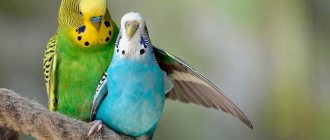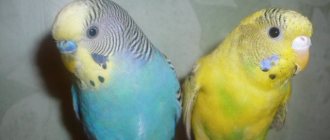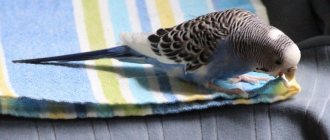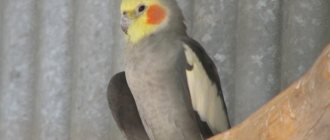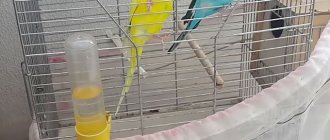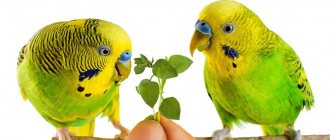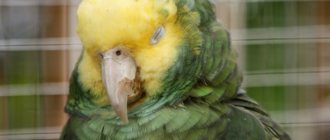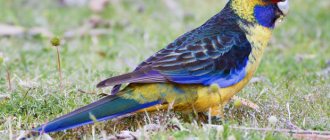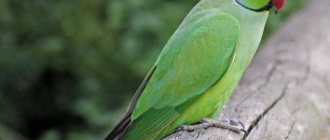- home
- Parrot
- Breeding
04/15/2019 Breeding animals is painstaking work. And if we are talking about such small pets as parrots, then he is also scrupulous. It is not enough to simply buy a couple of parrots and wait for replenishment. To obtain healthy offspring without harming the health of their parents, it is important to have certain knowledge. Let's look at the main points on how to avoid mistakes.
At what age do parrots start laying eggs?
Ideal breed options that should be chosen for further breeding by inexperienced owners are cockatiels, wavy and lovebirds.
The first ones are ready for procreation immediately after reaching 7-8 months of age. A common problem at this age is the lack of experience of young parents, which is why most of the chicks that emerge may die. Sometimes it happens that the female cannot lay an egg due to an underdeveloped oviduct. In this case, there is only one option left - a trip to the veterinary clinic.
It is better to choose individuals between 2 and 5 years old.
Budgerigars are ready to breed at the age of 6-7 months. But such an early age can lead to the fact that the male never begins to speak, and the female may even die. The fact is that when living in captivity, the genitals develop worse and more slowly than in the wild. It is better to take birds whose age is a year or more.
The suitable age for breeding lovebirds begins at 9 months, but this should not be done right away. The male and female are not yet ready for the chicks to appear, which is why they do not really monitor them or surround them with overprotection. In both cases, it is the feathered children who ultimately suffer.
It is better to wait until the first birthday; sexual maturity lasts until 4 years.
Disinfection
All equipment, items and accessories that will be used during the breeding season of parrots must be disinfected. These include:
- Cell;
- bowls for food and drink;
- toys.
Each of these items is disinfected in one way. To do this you need:
- Dissolve a weak solution of bleach or bleach in hot water.
- Soak the item to be disinfected in the resulting liquid.
- Rinse and clean the item with a brush.
- Rinse the item thoroughly.
The nesting house also needs disinfection, but in a different way. Step-by-step procedure:
- Disassemble the structure of the house into parts.
- Clean all elements with a brush dipped in water and baby soap.
- Dry everything thoroughly.
- Depending on the material from which the nest is made, the washed and dried house is calcined either in an oven preheated to +120°C for 30-40 minutes, or on a gas burner until the outer wall is heated. Plastic houses are kept in the sun for 6-8 hours.
The nest filler (hay or sawdust) must be pre-mixed with dried medicinal chamomile in equal proportions before placing it in the house - this will prevent the appearance of parasites (ticks, etc.) in the filler, and will also strengthen the bird’s nervous system. The floor in the house should not be open. Before the chicks hatch, it is not recommended to sprinkle sawdust on the floor of the nest - the egg may get lost in it. Therefore, it is better to use hay first, and after the chicks are born, place sawdust in the house.
How does courtship work in parrots?
The mating season for budgerigars is a very interesting time. The male constantly looks after his soul mate - feeds her, cleans her, constantly dances around and sings, tries with all his might to show his beauty. In response, the female constantly clings to her partner and squints her eyes. Birds have sex in the following way: the female sits lower, and the male climbs on top and begins the act of intercourse.
Pair selection
They didn’t find a friend right away.
The first applicant turned out to be weak, too young. Our Kesha attacked him like a kite. The future groom clearly did not live up to expectations, and we urgently returned him to the pet store, replacing him with an adult male. The new gentleman was the complete opposite of the first - confident and persistent, in a word - just what was needed. The bright green color and proud posture had the desired effect on Kesha. She was fascinated, but made no attempts to get acquainted. She just sat on the perch and waited. The male was named Gosha.
Gosha quickly got used to it and from the first day began to tirelessly look after Kesha: he cooed tirelessly, looking into his eyes, and danced “stompers.” One could admire this funny spectacle endlessly. But our Kesha, a flint, pretended that she didn’t see or hear anything.
As it turned out, it was a nest, no living space - no relationship! The husband took up the task of making a nesting box.
Behavior during mating season
It happens that some owners do not understand that the birds are starting to mate. Before starting this procedure, the couple should be placed in a separate cage or box. You need to pour sawdust into the bottom and then add chamomile.
The plumage changes during mating - the color of the male's chin becomes bright blue, and that of females - brown. At the same time, the activity of the birds increases - the male constantly flies around the cage and calls his girlfriend to him.
You should take care of feeding in advance - the female will need calcium and phosphorus to produce healthy offspring.
Nutrition
The daily menu for parent parrots should be balanced, vitamin-rich and nutritious. Every day before breeding, parrots are fed:
- Grains and cereals;
- greens;
- vegetables;
- seeds;
- fruits;
- egg (preferably quail, but chicken can also be used);
- cottage cheese 2% fat;
- sprouted grains;
- mineral supplements;
- calcium (chalk or eggshells);
- porridge;
- steamed grains.
All food must be fresh, and any uneaten leftovers must be removed. The water must also be fresh, clean, and changed daily.
Parrots always need a varied diet, without reference to reproduction. It is necessary that the birds are accustomed to such a diet and calmly consume all products. If for birds a varied menu is a novelty and their usual diet is limited to 2-3 products, then breeding parrots will not only not be possible, but is also prohibited.
In order to produce healthy offspring, normally lay eggs and hatch them, and then feed the chicks, the bird needs a large amount of nutrients - a parrot with a meager or monotonous diet simply does not have enough of them. Even if the bird manages to lay eggs, the embryos in them will either be underdeveloped or have birth defects.
During the breeding season, the female parrot especially needs increased feeding, because it is her body that will have to form embryos, lay eggs and other stages of reproduction. To ensure the normal formation of the embryo and egg, it is recommended to additionally feed the birds every other day with a special gruel, which is a mixture of crushed ingredients:
You should not feed birds this porridge more often than every other day. Otherwise, feeding will cause harm, not benefit. Due to the excess protein that this mixture is saturated with, the parrots will experience hormonal imbalance, the functioning of the gastrointestinal tract will be disrupted, and they will also become aggressive.
During the breeding season, it is important to monitor the consumption of wavy fish:
- Mineral stone;
- mineral mixture;
- sepia.
They should consume more of them than usual. If this does not happen, you will have to supply the birds with the necessary substances by mixing calcium gluconate into the food (available in tablets, you need to crush it into powder).
Breeding conditions
In the wild, birds breed mainly in the summer - at this time of year there are many sunny days, the air temperature is quite high, and there are no problems with food and water. At home, the owner can create suitable conditions on his own; it is not very difficult to do. One of the most important conditions is that the choice of a couple is not forced. In the absence of sympathy, the female will attack her chosen one, and such a couple will not have offspring. In case of mutual sympathy, males may appear very soon.
During the mating games of parrots, the birds must be placed in a separate cage with a necessarily prepared house for the parrots. In its absence, the birds will still carry out the mating process, but the eggs will ultimately be unfertilized.
To produce healthy, hungry chicks, you need to pay special attention to the birds’ nutrition. It is necessary to add mineral supplements and vitamins. You will also need to monitor the light - it is necessary to artificially increase the length of the day to 16 hours.
Starting a family
Equally important is the selection of a pair. By nature, parrots are monogamous; once sympathy occurs, it persists throughout life. It has been noticed that in wild conditions it is the female who initiates the acquaintance with the future partner.
If the owner has an adult parrot, then a young female four months old is selected to create a bird family. As the female grows up, the pair will become friends, and the female will not show aggression towards her partner.
If the owner has a sexually mature female, then an experienced male is purchased for company. In this case, the female's dominance will be muted. After purchase, the parrots are kept in different cages. If the birds show interest in each other, after a few days the newcomer is placed with the old-timer.
If the owner gets a pair of parrots, it is important to make sure that the pets are not related. Mating is possible, but, unfortunately, there is a high probability of genetic abnormalities in the offspring.
What do you name your feathered friend?
Nesting
The nest is an important component of the reproduction of feathered pets. Suitable size 17*25*17. Outwardly it looks like a birdhouse, which is attached to the bars of the cage, and not to the tree. Pet stores sell ready-made options, but you can assemble the house yourself, saving a decent amount.
It is necessary to pour sawdust into the bottom of the house to keep the eggs in a stable position. To eliminate possible problems with bird diseases, you need to use dry chamomile, sprinkling it on top.
It is not worth moving it again, this may frighten the birds and healthy offspring will not be born.
Laying eggs
Two weeks after mating, the first egg appears. As soon as their number reaches five, the female begins incubation. The size of the bird is inversely proportional to the number of eggs in the tub. On average, the female warms her eggs from eighteen to thirty-five days. The exact time depends on the conditions in the house and the size of the bird. The male most often only feeds the young mother, and in some cases also replaces her as a hen.
Hatching period
In a young family, the roles of each partner are clearly divided. The young mother hatches the future chicks, and the father feeds her and sometimes scratches her feathers. A row of bird husbands may sit at the entrance to the house and sing. Sometimes the female flies out of the nest for a short time, it must be used wisely. The owner can clean the house, for example, at any other time the young mother will aggressively attack her owner.
It would also be useful to familiarize yourself with a number of tips that will simplify the reproduction process:
- To clean an egg, place it in a container of warm water for a while, and then wash it with a rag.
- You can seal a small crack with an ordinary adhesive plaster.
- You should wash the eggs carefully, otherwise the embryo may die.
Fruit identification
Ten days after the appearance of the first egg, the owner can independently determine the fertilization of each of them. To do this, you will need to take one of them and shine it with a flashlight. If there are pulsating vessels inside, a simple conclusion can be drawn - it is fertilized. If fertilization does not occur, do not immediately throw out the egg, it can warm the rest. Large parrots usually have from 2 to 4 chicks, small ones - twice as many.
The appearance of chicks
The young offspring begin to peck the egg from the blunt end from the inside. Occasionally, a situation occurs in which twins may hatch. 12 hours after the appearance of the first cub, the entire brood begins to be fed by the young parents. Young birds are blind and have no feathers on their bodies; after a week, feathers begin to grow and their eyes open for the first time. After a month, the young parrot looks like an adult.
The period of stay of young offspring in the house with their parents is from one month to four. Usually birds begin to try to fly, but the first attempts rarely end successfully. Well, a month after the first independent flight, the cubs can be transferred to a separate cage.
Place for a nesting house
Books on breeding parrots recommend hanging nesting boxes on walls. We decided to go a different route; we didn’t want to spoil the walls at all.
Photo: Depositphotos
As soon as the nesting house was made, the cage with the parrots moved from the shelf in the hallway to the coffee table in the living room. Here it was more convenient to admire the relationships of our pets and then the chicks. They laid an oilcloth on the table, placed a cage on it, and next to it a nesting box.
Possible problems
Breeding parrots yourself is a very complex process that requires a huge amount of attention. In this case, a number of problems may arise that are characteristic of absolutely all breeds. It often happens that parrots simply do not begin to mate. Usually the problem is that suitable conditions have not been created for the birds. Maybe the daylight hours are too short (shorter than 15-16 hours), or the house for the chicks is not good enough.
If fertilization does not occur within a month, the house should be removed from the cage, otherwise it will not be perceived as an object necessary for reproduction.
Occasionally, a situation occurs when the female does not begin incubation. In this case, most often the problem is with the female; if she is not experienced, she will begin incubation from the second. In the case of the first clutch, there are also situations when the female lays eggs not in a specially designated house, but inside the cage. The best advice in this case is to replace the birdhouse with a new one.
The house can also become a battle area. This sometimes happens in the case of incorrectly determined gender - sometimes a male is mistaken for a female. If there is only one house for two young mothers, they will do their best to destroy their rival’s clutch.
If the female throws the eggs out of the nest, she most likely smelled a foreign scent on the surface.
Egg laying and incubation
Disinfection
Before the start of the nesting season, parrots are removed from the cage and subjected to thorough cleaning and disinfection. The procedure must be repeated after each hatching of the chicks, when they have already left the house.
How to make a nest for budgies #nest #how to make a nest #budgie
While nursing the babies, the nest box is cleaned once a week, replacing the sawdust with new ones. However, there are birds that react painfully to this and may even abandon their clutch or brood. Such birds should not be disturbed again until the young birds fly out.
Determination of egg quality
A fertilized egg is usually identified by its appearance. Its shell is matte, grayish-white. Unfertilized - yellowish, sometimes simply spotted, shiny.
Incubation period for budgie eggs
In wavy birds, the chicks hatch on the 18-19th day after the female begins incubating the eggs. In other species this happens later. For example, for lovebirds and cockatiels - after 21-22 days, and for rosella - after 22-23. In large birds, the incubation period can reach 30 days.
HOW TO BREED BUDGETS HOW TO SELECT A PAIR NUMBER BUDGETS CHICKS
Chick development
The barely hatched chicks bear little resemblance to their handsome parents. The chicks are born weighing 1 g, blind and deaf. They have neither plumage nor even edges. They cannot hold their head up on their own and at first they just lie down.
Three-day-old chicks already weigh 4 g, but still lie. Further development occurs day by day according to the following schedule:
- 6th – raise their head, open their eyes;
- 8th – sit down;
- 10th – focus the gaze;
- 14th – pubescent;
- 18th - acquire the colors of the future plumage;
- 20th – acquire sexual characteristics;
- 24th – covered with tiny feathers, gaining maximum body weight;
- 29th – completely covered with feathers.
1-1.5 months after birth, the chicks fly out of the parent's nest. 2 weeks after this, they should be housed in separate cages.
Is it worth interfering?
Most breeders try to take an active part in the life of their parrots, even during the breeding season. Birds at this time require solitude and peace. Don't take care of them too obsessively.
It is important to monitor the reaction of parrots (especially the female) to penetration into their territory. If the female becomes nervous and aggressive, as soon as the owner puts his hand into the family nest, it is better to leave the parrots alone and not disturb them. Obsessive care will only do harm.
If the breeder needs to inspect the clutch, etc., this should only be done when the female leaves the nest. There is no need to touch the eggs again. Before you pick them up, you need to put on medical gloves or rub your hands with chamomile powder mixed into the filler. Otherwise, the female will abandon the clutch, sensing a foreign odor from the eggs.
To control the correct order of hatching of chicks, experienced breeders put a serial number on each egg that appears in the nest. To do this, it is better to use a simple pencil with a soft lead. This will allow you to identify frozen eggs. For example, if the 2nd and 3rd chicks have already hatched, and egg number 1 is still intact, this is a signal that, most likely, the embryo in it is dead.
